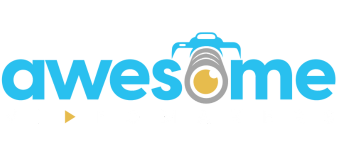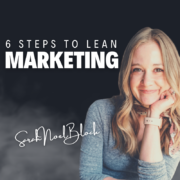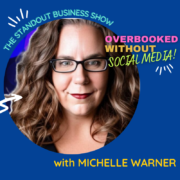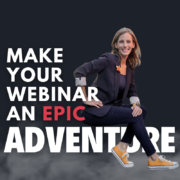145. Lean Marketing in 6 Simple Steps – with Sarah Noel Block
How can you create a lean marketing strategy for your B2B service business that’s easy for you to maintain – even without a marketing department?
That’s the question we’re answering in this latest installment of our “Market Less, Matter More” series, featuring the brilliant Sarah Noel Block, MS founder of Tiny Marketing by Sarah Noel Block.
Sarah simplifies B2B marketing for small teams with her innovative lean strategy, focusing on genuine connections over flashy tactics.
You’ll learn how to streamline your efforts with just
✅ one dream client,
✅ one signature offer,
✅ one main social channel,
✅ one core content piece,
✅ two lead generators,
✅ and one gateway offer.
Sarah also shares practical tips for building trust and refining your offers through client interviews.
Don’t forget that you can join us live on the 4th Wednesday of each month for our monthly marketing forum series, where you can continue learning and connecting with experts.
Subscribe to be notified and also watch the live video replays
Don’t miss out on Sarah’s invaluable insights—visit sarahnoelblock.com and check out her Tiny Marketing Club for more resources.
Transcript
Brad Powell:
Welcome to the Standout Show. I’m Brad Powell and I’m a video marketing coach, and today I’m joined by my new co-host, personal brand expert Eva Chen, and Eva and I are launching our new series that we’re calling Market Less Matter, more. So why are we doing this? Well, as you’ve probably noticed, the world of marketing is full of all kinds of what I can only call garbage. A lot of what’s being labeled as marketing is really just a bunch of BS. It’s either something that worked in the past but it doesn’t really work anymore, or it just wasn’t really helpful to begin with.
Eva Chen:
We’re on a mission to help you filter out all the market tactics that don’t fit you so that you can focus on what really matters connecting on a deeper, more meaningful level to attract your best customers, and in a way that’s uniquely and authentically you. So this show is for entrepreneurs who want to build a sustainable, profitable business, and it’s for those who want to do more of what they love, have more impact and spend a whole lot less time marketing.
Brad Powell:
And we’re changing the format. So, instead of doing interviews, this new series is going to have short to the point 10 minute presentations. So with each new episode, we want you to walk away with quick, actionable tips that you can bring straight into your business. And with that, let’s start the show. Today we’re joined by Tiny Marketing Agency founder Sarah Noel Block. Sarah is going to talk about lean marketing in six simple steps, which is all about how to create a lean marketing strategy for your B2B service that you can maintain even without a marketing department. So stay tuned and let’s start the show.
Brad Powell:
I want to plug Sarah’s great podcast, the Tiny Marketing Podcast, the thing that I like about it among her guests and all the stuff that she’s sharing. This podcast actually comes out. The feed comes on a Sunday and I know that, as a podcast listener, sunday is not a good day usually. So I was like, oh good, you know, sarah’s podcast is here and it’s kind of like, if you’re looking for something to listen to that is marketing related and kind of fun on your Sunday feed, this is one of them.
Sarah Noel Block:
I’m surprised by how many people listen when it drops. I drop it Sunday at midnight, oh right, there you go.
Brad Powell:
It’s a good time, I think, for it to appear, so there you go, yeah it’s doing just fine.
Sarah Noel Block:
So there’s some Sunday marketers out there.
Brad Powell:
All right. Well, I’m going to turn it over to you. Sarah, You’re on.
Sarah Noel Block:
Yes, Thank you. My talk plays so well with Michelle’s because everything that I’m teaching you today with this tiny marketing strategy is about building relationships and how you can do that at scale. So it’s kind of like you know, going back in time looking at her presentation, that relationship versus mass market. It kind of meets you in the middle, there where you’re leveraging visibility and authority, marketing to build relationships. So let’s get into it. My flywheel looks like this you have one dream client that you know you can serve, one signature offer and I’ll get into all of these a little bit more later one main social channel, one core content, two lead generators and one gateway offer. So that is all you need. That’s it. And every little bit of this builds relationships with your ideal customer. And let’s get into how. So this is perfect.
Sarah Noel Block:
If you can’t get prospects on a sales call, you’re struggling to network, it doesn’t really feel good to you and you’re not sure how to do it. Awkward without feeling awkward. If you’re getting too many wrong fit leads, if you’re getting pushback on, if you can solve the problem, if you can’t get prospects to even notice you exist, you’re lacking visibility and authority and you’re getting objections about your price. This strategy will work for you because you’re building trust every step of the way and you’re building relationships and, as Michelle was saying, that warm introduction to someone is a great way to get a job. So one dream client. To make this whole strategy work, you need to start with having one dream client that you want to clone. So look at your favorite client. Who do you want to replicate? Start interviewing them, finding out what their biggest challenges are. What do they wish that your offer looked like? What transformation would they love for you to go through? And if you don’t know who your dream client is, you can start having those conversations with people that you think might fall into that bucket. Review the sales transcripts from the calls that you’ve already had to find out what are the challenges that they’re going through. What goals do they have? Join forums where they’re likely hanging out and do a little digging. People are asking questions, asking for advice on there all the time. That’s a whole lot of information that can help you market better.
Sarah Noel Block:
One of the things I love to do is I look at the reviews for books that are similar to my offer. So, like StoryBrand is similar in that you’re talking to one specific audience and you’re making them the hero of the stories. But I do things a little bit different. So what I did is I took the reviews from StoryBrand book and put it in ChatGPT and I said ChatGPT, tell me, what do people wish was in this book? That there isn’t. What do people complain about? And that gave me a whole lot of ideas about how to position my offer, because I knew that the people likely reading this book are my ideal customers. But I want to know what they want from my offer and start scheduling connection calls. Those are easy, no-pressure conversations, just networking conversations. But it’s a good time to start talking about what your offer is, what you’re considering to be an offer, and just get some feedback on it. And 50% of the time they’ll be like you know what, I know somebody, or that would really be a great offer for me. So you can get feedback and potentially start teasing out the offer and getting people on a waitlist for it.
Sarah Noel Block:
Now, if you have no idea who your dream client is, you’re not alone. Lots of people don’t know when they are just starting out. It takes time and testing to see who is the perfect fit for your client questions that you want to start asking yourself what problem do I solve better than others? What transformation have I helped people go through? What challenges would someone need to be going through to need that transformation in the first place? What type of person or business would feel this pain the most, and who needs this transformation more than anyone else? Look at all of those things. Who can you help really easily and change their life? That’s who your dream client is, and there is very specific attributes that will be that that person will have.
Sarah Noel Block:
The next step is one signature offer. So you want to direct your dream client to one signature offer so it’s super easy to understand how they can work with you. And that doesn’t mean that you need to have only one offer. But you want to have a signature offer that you’re known for a bullseye, that one you can use for revenue forecasting, because you know how much that signature offer is, so you can figure out how many relationships you need to build in order to meet those revenue goals. But also it’s just easier to sell. You can also have an upsell from there, a bigger version of that signature offer, a downsell for people who can’t afford that signature offer, and back-end add-ons that you can have only available to people who have gone through that signature offer. Only available to people who have gone through that signature offer. No-transcript.
Sarah Noel Block:
Next is one main channel. So, despite what you hear, you don’t have to be everywhere. You don’t have to be on every social media channel, but I do recommend that you have profiles on all of those channels. So choose the one channel that your customer is most likely on and if you’re having those conversations, like I said during the dream client section, you’ll know what channel that they’re on. But on those other channels, lock in your accounts on all of them. So, and put the little location emoji and say what channel you’re actually spending time on. So, like the little emoji. And then LinkedIn find me at LinkedIn. And then use the pin post to do three things Tell them what you do and who you do it for. Take them to your lead generator and tell them where you spend your time online. Now, your main social media channel. That’s where the relationships are being built. I use LinkedIn for that, and if you are in all of the different channels, you’re not going to be able to build relationships and understand the algorithm on all of those channels, not when you’re one person. So, oh, I have to close these chats because they are distracting. So you want to use that main channel for relationship building and getting known, building that visibility there.
Sarah Noel Block:
One core content, choose one core content and a cadence that you can commit to. It’s all about trust. So that core content if you say you’re going to produce your podcast once a week and then you show up every three months, you’re going to lose some trust. So I’m going to give you some options, because the pushback that I always get is you, I don’t have time for this. So I’m giving you some options that you will have time for. So here’s my 4C method for. So here’s my 4C method.
Sarah Noel Block:
Core content that’s what I usually recommend you go with eventually is episodic or series content that you commit to doing on a regular basis and that’s like a podcast or this show which is once a month. So you see, it could be once a week, it could be once a month. Just commit, Do what you say you’re going to do. The next one is campaign content and that’s batch creating your content around a specific offer. So you look at your offer and you break it down like what objections am I going to get on that? What transformations will people go through? What are the limiting beliefs around this offer and create all of your content at one time? Beliefs around this offer and create all of your content at one time. Just sit down, do it, schedule it all out. Next is collab content. This is what I recommend people do very first.
Sarah Noel Block:
The first thing, because you’re borrowing someone else’s audience, just like we were talking about earlier. I told you this plays nicely. So to borrow someone else’s audience, you would be like co-hosting a webinar, doing something like this, doing a webinar swap. You could do a newsletter swap, you could guest on someone else’s podcast and then last takes the least amount of time and that’s curated content. So curated content is like, for an example, I create these curated playlists of podcasts on a very certain specific topic and then I’ll just put together a landing page for it so people can do it, can listen to it. It’s super valuable, but it takes me not that much time to put together. So these are all in order of what takes the most time. So core content will take the most time, curated content the least amount of time. And then, if you’re listening to this and you’re like, well, I still don’t have time for any of that. Choose a hybrid option that is a core content and lead generator all in one. So if you need to condense it, it can look like a webinar series, a workshop series, a private podcast that would be gated to get access to it. Virtual summits, audio summits, panels, networking events, roundtables all of those things drive a ton of value for your audience and they’re worth submitting your email for. But that’s the thing is, you’re also generating leads from it because you’re getting those emails from it. So if you have next to no time, do the hybrid option.
Sarah Noel Block:
The two lead generators is the next piece of this flywheel. So you want two lead generators. You want one that’s passive and one that is active. So a passive lead generator is always on. It’s like a quiz, a PDF, a template, a private podcast, guide, mini course. It lives on your website. It’s maybe a pop-up that you’ll see there and maybe it’s in your email signature, but it always exists. An active lead generator is time-sensitive. So this can look like a panel, a webinar, a workshop. It provides some FOMO and it will get a rush of people all at one time because there’s a time sensitivity to it, obviously hence the name and they need to do it within a certain amount of time. Where the passive lead generators drip but you constantly get new leads, but they drip in slower where you’re going to get a bum rush with the active. So I recommend both.
Sarah Noel Block:
One gateway offer is the last piece of this flywheel. So this is a high-value, low-cost entry point to working with you so you can earn trust with people. This can look like a lot of different ways, but I’ll get into that in a second. Pick one that’s easy to replicate Because it’s high-value, low-cost. You want it to be easy enough to do.
Sarah Noel Block:
Is there a part of your bigger signature offer that you can break off into a standalone, Like my strategic story? I broke off the beginning part of it into the strategic spark, which is valuable enough on its own, but it can stand alone and someone can take it and execute it on their own. And then, what is something your dream client needs to be prepared for? To work with you on that bigger offer? That’s another great opportunity. So you can like whatever would be in the pre-work category before they work with you on your signature offer could be a gateway offer. So this can look like an audit, a strategy, a report, a brief.
Sarah Noel Block:
These are all great ways to gather information about your client and build out something that can be useful to them, that you can execute or they can execute. That’s why it’s a gateway offer, because it provides a mechanism like a scope for what you can do. But they can also take it and run with it. The point is you want to earn their trust. That’s why it’s low cost. They’re testing you out, they’re seeing if you’re a good fit and then understand the scope of what they’ll need in the future.
Sarah Noel Block:
So when you do these gateway offers, you’re gathering all of the information that you’ll need about them and you’ll know what you should be selling on the back end, what you should upsell them to later or what would make sense a quarter from now.
Sarah Noel Block:
Whenever you can, you can put in optimizations or audits within like every quarter, and those give you opportunities for up can refine everything. So your gateway offer allows you to interview your dream clients. You understand where they’re at now, the challenges they’re dealing with, what their goals are, where they spend their time online, how they make buying decisions, and then you can go all the way back to the beginning and you can refine it. Like, okay, I’ve done these gateway offers and I’ve realized I don’t really like working with X, so you can cut that and make a new dream client avatar. You’ll have a better idea of what that signature offer should look like after learning what transformations they want. You’ll know where they spend their time online, what kind of content they like, what lead generators would actually benefit them, and then you start all over again. So it all plays really really nicely together and that is that. That is the entire tiny marketing strategy flywheel that gets better and better every year because you’re getting the information you need from that gateway offer to refine it.
Brad Powell:
Yeah, you know a couple takeaways that I just want to share quickly. One is just that the whole thing about one like focusing on one I can’t underline that more, you know, emphatically, it’s like if the trouble with entrepreneurial folk and I am as guilty of this as anyone is that we have. The reason that we do the stuff we do is we have tons of ideas, we’re super creative and we’re completely addicted to the new. The shiny is like oh, I have, I have 100 ideas this morning. Let’s do all of them.
Sarah Noel Block:
Yeah, you know what?
Brad Powell:
The best marketing, the most successful marketing, feels really boring to you because it’s working and it’s repeatable.
Brad Powell:
Do in the marketing realm is really combining what you guys have both been talking about.
Brad Powell:
I mean, this is an example of that you know I look at.
Brad Powell:
Well, how can I develop a really cool bunch of relationships and bring on some of my favorite people and or somebody who might possibly be a dream client and have a real, genuine, long, meaningful exchange with them and do it in a way that not only are we doing it like whoever I’m with in this process, but now, as we see in the chat and the people who are watching live, there’s a bunch of other people participating at the same time, which is more relationship and community building.
Brad Powell:
And then, of course, because all of this is being recorded in fact, this is being recorded on four separate pieces of recordings, like four separate videos. Now I have, if I want to do content marketing, if I want to get on that gerbil wheel, I’ve already got a ton of content just from this one event and that is going to last me for some time to come in terms of who else is interested in sharing that around and all that kind of thing of who else is interested in sharing that around and all that kind of thing and this, this people would think of. People think about content creation and content marketing and podcasting, all these things. They have this vision of it that makes it seem much harder than actually it really needs to be in many cases.
Sarah Noel Block:
Yeah, yeah and that’s it. Content marketing is such a great relationship builder when you are collaborating with people we met through content marketing.
Brad Powell:
We did Right, all right. Well, we have a couple. Let me see here, all right. So Brady’s on here and he says, see if I can bring this on, what’s the best way to know when to upsell somebody? What is the best way to know when to upsell somebody?
Sarah Noel Block:
What is the best way to know when to upsell someone. So what I do is, during that scoping period, during that gateway offer, I have already identified the roadmap of what would make sense for them to do a year from now. So I just plan into my signature offer quarterly check-ins or audits, optimizations, so that I have a reason to say okay, this is the point in the year that you should be doing X, so let’s get this rolling. So that’s how I do it.
Brad Powell:
Right, cool, well, all right. So there’s a longer list here. So it says let’s see Okay, so percentage that we should be targeting. I have clients that want to upgrade but then they decided they don’t want. They don’t want them to because we try to, I can’t. The whole thing isn’t here, well. I’m guessing it tried’ll try to upsell them too much. That’s the end of that sentence at the end.
Sarah Noel Block:
If you plan it out in the gateway offer, like when you are delivering, whatever that documented gateway offer looks like and you put in there what would make sense for them to do, what their roadmap looks like, then they’re primed and they’re expecting to hear from you at certain points in the year on what would make sense. So that’s an easier way to do it and also just read the room. You know when you’re having those conversations with people if they’re interested in upselling or if they’re like all right, I’ve maxed out my budget enough. So it’s a little bit of strategy within that initial scoping period and a little bit of psychology and reading if they’re interested and open to it.
Brad Powell:
Yeah, yeah, great.
Eva Chen:
All right, Eva, you have something you want to share question do you have like suggestions for people if if they’re not sure how, like what content to what to say? Is it from your research or how do you? How does somebody get started?
Sarah Noel Block:
Well, if you don’t know what to say, the first thing I do is go on my sales transcripts and start seeing what questions pop up. Just listening to people helps a lot. I’m in a fortunate circumstance where I’m having conversations with my clients and my clients’ clients constantly as I’m building out their own strategies so I have more insight into what people care about. But just listening to those questions. Looking at your social media, what comments are people putting on there that you could respond to in content? All of my friends joke because I say everything is content. Basically every conversation I have. I can tie it back to some sort of content. But it comes down to what are those frequently asked questions? Go through your offer. When I don’t know what I’m talking like, don’t know what to talk about on social media, I pull up this flywheel that I showed you guys and I think about the questions that come up, about little pieces of it. I just break off a little piece of it and talk about it.
Eva Chen:
No, I love that. It’s like we make things so complicated right.
Sarah Noel Block:
Yeah, and it’s all probably right there on your website. Just break a little piece off.
Brad Powell:
All right. Well, I think we’ll start to wrap this up. I want to just thank you both for coming on today. This was really cool. This is the first iteration of this particular forum. It’s going to happen on the fourth Wednesday of the month. Sarah what’s the best way to connect with you?
Sarah Noel Block:
They can find me at sarahnoelblockcom my name. What’s the best way to connect with you? They can find me at sarahnoelblockcom my name. You can go to sarahnoelblockcom slash club if you want to watch the whole masterclass on the piece that I talked about today. There’s a bigger version there and you can learn more about how to join the Tiny Marketing Club, and you know I’ll hold your hand as we work through your own marketing hand as we work through your own marketing.
Brad Powell:
Thank you all for coming on today. This has been brilliant and for all the folks joining live. Thank you all for being here and stay tuned for more of this coming on the fourth Wednesday next month, and with that I’m going to say goodbye. So long.









